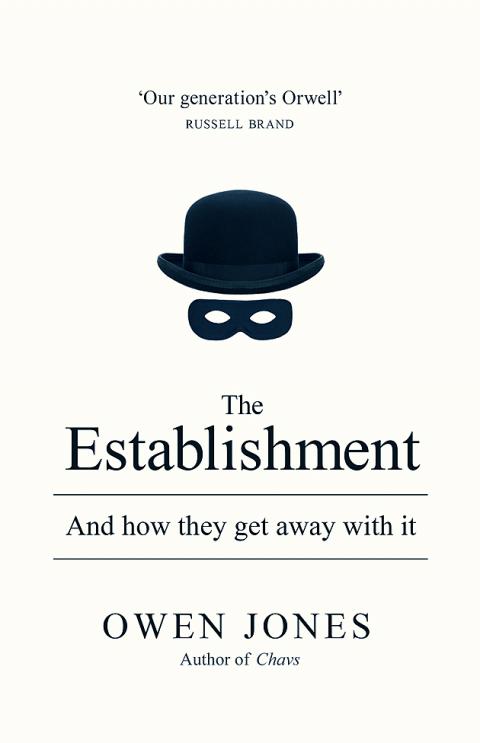If you don’t know who Owen Jones is it’s probably time to find out. He’s a young political commentator, still only 30, though he looks much younger, and omnipresent on YouTube. He’s notable for being what the British left has long needed, a charismatic voice espousing what are in some quarters its distinctly unfashionable views.
In The Establishment, his second book, Jones presents a blistering picture of the UK today. Whereas the term “Establishment” in the 1960s, when it was invented, summoned up images of privately-educated gentlemen eating expensive meals and quietly arranging national policy behind the scenes, in Jones’s usage it comes to stand for a voracious financial sector that dictates government policy, a corrupt police-force working to reinforce that same government’s class-based and sometimes anti-immigrant policies, a widespread reluctance by the ultra-rich and their companies to pay any taxes at all, some of the strictest anti-trades-union legislation in Europe, and the punishment of the poor for minor misdemeanors while the very rich get bailed out by the state for what are far more heinous crimes.
This is fighting talk, and just what the parliamentary opposition needs after the centrist, and even center-right, policies of New Labor when in power under Tony Blair and Gordon Brown, and the perceived lack of charisma of its present leadership.

Jones has all the right credentials for such a role. He was born into a working-class but highly political northern family, educated at state schools, then got into Oxford where he graduated with a degree in history. After working on London’s The Independent newspaper, he moved to The Guardian earlier this year, and is a frequent invitee to TV political talk-shows where his combined charm and persuasiveness can’t help making a strong impression.
What, then, does The Establishment argue? Essentially, that for several decades after World War II there was an implicit consensus in the UK that state influence in economic and social life was both inevitable and beneficial, and that a mixed economy, state-controlled plus private, was the norm. With the ascent to power of Margaret Thatcher in 1979, this changed, and what Jones calls the Establishment mantra, that a free market is good for everyone and government influence is invariably stifling of initiative, came to prominence. New Labor, too, swung to the right (now seen as the center), and voices such as Jones’s came to be perceived as “out of touch with reality,” and even “extreme.”
Life in the City of London, the financial center, is chillingly portrayed. “Some of the sexism, homophobia and racism was just staggering,” one employee is quoted as saying. Just mention the sufferings of the poor on the dealing floors and you were shouted down. Yet these people, Jones says, were allowed to transform themselves into “giant casinos, taking huge bets with other people’s money in a desperate rush to make untold riches.” In 2012, in addition, 2,714 UK bankers were paid a million pounds [NT$49 million] a year or more, 12 times as many as in any other EU country. But when such banks failed they were, as in the US, bailed out by the taxpayer.
The reluctance of corporations to pay tax is also highlighted. Their accountants are hired by government to help frame tax laws, then, for a fee, advise the private sector of the loop-holes. The largest taxpayers negotiate what they should pay with the HMRC (the UK tax department), then often delay paying what’s been agreed. Those owing small amounts, by contrast, are mercilessly pursued over any defaults.
The UK has an extensive system of weekly payments for the unemployed and the disabled, and one of this book’s targets is the government’s strategies for reducing the number of people claiming these benefits. Jones subjects two companies employed by the UK government to do this, Atos and A4e, to detailed analysis. In a three-month period in 2012, he writes, 42 percent of appeals against work capacity judgments by the former were upheld, while the latter’s attempts to get people back to work are described as “shambolic” (the company ended its contract in March last year).
These are examples of one of Jones’s most persistent themes: the way private firms enrich themselves at government expense. This can be found in the chapter “Scrounging off the State,” a phrase that Jones here turns on its head. Rather than using it to refer to dishonest benefit claimants (as most of the media do), he employs it to refer to high-profile corporations that make millions from state contracts in areas such as health under the current Conservative/ Liberal-Democrat Coalition.
The police are the subject of another scathing chapter. Necessary for maintaining order, they are now often also an arm of repressive state policies, Jones says, citing “endemic racism; deaths following police contact … the indiscriminate stop-and-search of young black men; the harassment of protesters … attacks on trade unionists,” and the forming of long-term sexual relationships with female dissidents by some of the 1,200 undercover officers (a number cited earlier this week) allegedly operating in the country.
Other Jones themes are the “revolving door” through which men and women move from politics into lucrative business jobs and vice-versa, and the lack of any strong popular movement to deflect the people’s anger upwards against the bankers, rather than downwards against immigrants and benefit claimants.
Following the success of the far-right UK Independence Party (Ukip) in last week’s by-elections, Jones wrote in The Guardian that “a discredited elite that unleashed the beast of right-wing populism is not going to defeat it.” It was a conclusion that included all the other parties, his own political left included.
But he offered no solution other than “soul-searching.” This new book, then, remains his essential analysis, and recommendable for anyone concerned with UK politics and with a relatively radical turn of mind — even if last week suggested that few in the UK itself are attending to what is by any standards its shocking and disturbing message.

Oct. 27 to Nov. 2 Over a breakfast of soymilk and fried dough costing less than NT$400, seven officials and engineers agreed on a NT$400 million plan — unaware that it would mark the beginning of Taiwan’s semiconductor empire. It was a cold February morning in 1974. Gathered at the unassuming shop were Economics minister Sun Yun-hsuan (孫運璿), director-general of Transportation and Communications Kao Yu-shu (高玉樹), Industrial Technology Research Institute (ITRI) president Wang Chao-chen (王兆振), Telecommunications Laboratories director Kang Pao-huang (康寶煌), Executive Yuan secretary-general Fei Hua (費驊), director-general of Telecommunications Fang Hsien-chi (方賢齊) and Radio Corporation of America (RCA) Laboratories director Pan
The consensus on the Chinese Nationalist Party (KMT) chair race is that Cheng Li-wun (鄭麗文) ran a populist, ideological back-to-basics campaign and soundly defeated former Taipei mayor Hau Lung-bin (郝龍斌), the candidate backed by the big institutional players. Cheng tapped into a wave of popular enthusiasm within the KMT, while the institutional players’ get-out-the-vote abilities fell flat, suggesting their power has weakened significantly. Yet, a closer look at the race paints a more complicated picture, raising questions about some analysts’ conclusions, including my own. TURNOUT Here is a surprising statistic: Turnout was 130,678, or 39.46 percent of the 331,145 eligible party

The classic warmth of a good old-fashioned izakaya beckons you in, all cozy nooks and dark wood finishes, as tables order a third round and waiters sling tapas-sized bites and assorted — sometimes unidentifiable — skewered meats. But there’s a romantic hush about this Ximending (西門町) hotspot, with cocktails savored, plating elegant and never rushed and daters and diners lit by candlelight and chandelier. Each chair is mismatched and the assorted tables appear to be the fanciest picks from a nearby flea market. A naked sewing mannequin stands in a dimly lit corner, adorned with antique mirrors and draped foliage

The election of Cheng Li-wun (鄭麗文) as chair of the Chinese Nationalist Party (KMT) marked a triumphant return of pride in the “Chinese” in the party name. Cheng wants Taiwanese to be proud to call themselves Chinese again. The unambiguous winner was a return to the KMT ideology that formed in the early 2000s under then chairman Lien Chan (連戰) and president Ma Ying-jeou (馬英九) put into practice as far as he could, until ultimately thwarted by hundreds of thousands of protestors thronging the streets in what became known as the Sunflower movement in 2014. Cheng is an unambiguous Chinese ethnonationalist,